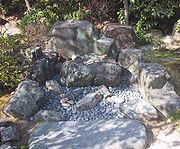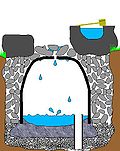
Suikinkutsu
Encyclopedia

Koto (musical instrument)
The koto is a traditional Japanese stringed musical instrument, similar to the Chinese guzheng, the Mongolian yatga, the Korean gayageum and the Vietnamese đàn tranh. The koto is the national instrument of Japan. Koto are about length, and made from kiri wood...
. It is usually built next to a traditional Japanese stone basin called chōzubachi
Chozubachi
is a vessel originally designed to keep water for rinsing one’s mouth and cleansing one’s body before worshipping gods or Buddhas. It subsequently evolved into what is called and became a fixture of the Japanese tea ceremony found within the yard surrounding the tea house....
, part of a tsukubai for washing hands before the Japanese tea ceremony
Japanese tea ceremony
The Japanese tea ceremony, also called the Way of Tea, is a Japanese cultural activity involving the ceremonial preparation and presentation of matcha, powdered green tea. In Japanese, it is called . The manner in which it is performed, or the art of its performance, is called...
.
Traditional construction
Constructing a suikinkutsu is more difficult than it looks, because all components have to be finely tuned with each other to ensure a good soundAcoustics
Acoustics is the interdisciplinary science that deals with the study of all mechanical waves in gases, liquids, and solids including vibration, sound, ultrasound and infrasound. A scientist who works in the field of acoustics is an acoustician while someone working in the field of acoustics...
. The most important piece of a suikinkutsu is the jar, the upside down pot buried underground. Initially, jars that were readily available for storage of rice or water were utilized for the construction of a suikinkutsu. Both glazed and unglazed ceramic
Ceramic
A ceramic is an inorganic, nonmetallic solid prepared by the action of heat and subsequent cooling. Ceramic materials may have a crystalline or partly crystalline structure, or may be amorphous...
jars can be used. Recently, metal suikinkutsu have also become commercially available. Unglazed jars are considered best, as the rough surface aids in the building of drops. The height ranges from 30 cm to 1 m, and the diameter from 30 cm to 50 cm. The hole at the top has a diameter of circa 2 cm. Similar to a bell
Bell (instrument)
A bell is a simple sound-making device. The bell is a percussion instrument and an idiophone. Its form is usually a hollow, cup-shaped object, which resonates upon being struck...
, the jar of a good suikinkutsu will ring when struck. A jar producing a good sound will create a good sounding suikinkutsu. Similarly, a cracked jar, like a cracked bell, will not produce a good sound.

Usually, only a single jar is buried underneath a chōzubachi Japanese stone basin. However, in some rare cases there may also be two suikinkutsu adjacent to each other in front of the same chōzubachi. Such a double installation can be found for example in front of the Iwasaki Castle, Nisshin
Nisshin, Aichi
is a city located in Aichi Prefecture, Japan.As of July 1, 2011, the city has an estimated population of 83,120, with 32,471 households and a population density of 2,381.66 persons per km². Its total area is 34.90 km².The city was founded on October 1, 1994....
city, Aichi Prefecture
Aichi Prefecture
is a prefecture of Japan located in the Chūbu region. The region of Aichi is also known as the Tōkai region. The capital is Nagoya. It is the focus of the Chūkyō Metropolitan Area.- History :...
, in the campus of the Takasaki Art Center College, Takasaki, Gunma prefecture, or in Kyoto University, Kyoto. However, having two openings about 50 cm apart means that it is difficult to cover the ergonomic best spot for washing hands with both openings. Thus, the creation of the sound is usually done intentionally by splashing water over the two designated spots, rather than accidentally by washing hands. Suikinkutsu with more than two jars may also be possible, although no reference for this is available.
Modern variations
There are a number of modern variations form the traditional suikinkutsu. the list below shows some of the possibilities for modern suikinkutsu.- Modern suikinkutsu are not always located next to a chōzubachi as traditionally required.
- Suikinkutsu can also be built with a continuous stream of water for a continuous suitekion sound instead of the ryūsuion and suitekion alteration (see below).
- Metal suikinkutsu are also available nowadays.
- Some above ground devices similar to a suikinkutsu have also been installed, for example as part of sculptures.
- Suikinkutsu are also installed indoors
- Commercial venues (restaurants, shops, and also offices) may have the sound of the indoor or outdoor suikinkutsu amplified electronically and played through speakers.
- An additional pipe may also be installed to convey the sound from the cavity in the suikinkutsu to another location, e.g. indoors.
History
Historically, suikinkutsu were known as , but they were rarely used in Japanese gardens. It is believed that initially a vessel was buried upside down next to the washing basin in Japanese gardens to act as a drainage system. This sometimes produced pleasant sounds, and gardeners subsequently sought to improve the sound quality of the device. Their rise in popularity and the name suikinkutsu originated from the middle of the Edo periodEdo period
The , or , is a division of Japanese history which was ruled by the shoguns of the Tokugawa family, running from 1603 to 1868. The political entity of this period was the Tokugawa shogunate....
(1603-1867), around the same time the stone basin chōzubachi was developed. The famous tea ceremony teacher Kobori Enshu of that time had a suikinkutsu in his garden, and he is subsequently often credited as the inventor of suikinkutsu. At the end of the Edo period, the creation of suikinkutsu became less frequent, but became popular again during the Meiji Era (1867-1912).
At the beginning of the 20th century, i.e. the early Showa period
Showa period
The , or Shōwa era, is the period of Japanese history corresponding to the reign of the Shōwa Emperor, Hirohito, from December 25, 1926 through January 7, 1989.The Shōwa period was longer than the reign of any previous Japanese emperor...
, both the name suikinkutsu and the device were all but forgotten, and a report of Professor Katsuzo Hirayama at the Tokyo University of Agriculture from 1959 could find only two suikinkutsu in Japan, both of them inoperable and filled with earth. However, a journalist from the Asahi Shimbun
Asahi Shimbun
The is the second most circulated out of the five national newspapers in Japan. Its circulation, which was 7.96 million for its morning edition and 3.1 million for its evening edition as of June 2010, was second behind that of Yomiuri Shimbun...
wrote about suikinkutsu in 1982, and requested information from the public about the topic. This led to a re-discovery of many suikinkutsu, and a number of articles about suikinkutsu in the Asahi Shimbun. Shortly thereafter, in 1985, NHK
NHK
NHK is Japan's national public broadcasting organization. NHK, which has always identified itself to its audiences by the English pronunciation of its initials, is a publicly owned corporation funded by viewers' payments of a television license fee....
aired a program about suikinkutsu on Japanese television, and sparked a suikinkutsu revival, with many new suikinkutsu installed.
Acoustics
The sound of a suikinkutsu has its own name in Japanese, called suikin'on. the sounds can furthermore be divided in two sub groups, ryūsuion and suitekion. The ryūsuion is the sound of the first few water drops at the beginning of washing hands. The suitekion describes both the sound of a lot of water falling at the same time during washing hands and the slower drops at the end of the washing.A superior suikinkutsu has water drops originating from different spots on the surface of the jar. Unglazed jars hold moisture better, and therefore have drops originate from more spots on the surface. The impact of the water on the surface creates a sound, that is amplified by the design of the jar. Some suikinkutsu do provide a bamboo tube nearby, which can amplify the sounds if one end is put on the ground near the top of the suikinkutsu and the other end is placed on the ear.
It is said that every suikinkutsu sounds different.
Philosophy
An important part of the idea behind the suikinkutsu is that the device is hidden from the view. Instead, the visitor washes his/her hands, and suddenly hears the pleasant sounds coming from underground. The act of washing the hands can also be considered as playing the suikinkutsu, and the sounds emerge shortly after the washing. This clear sound of water drops is considered relaxing and soothing, and also described as beautiful and peaceful.Miscellaneous
A commercial CD recording of the double suikinkutsu in the campus of the Takasaki Art Center College was made in 1995 and is available from Victor Records. Another artist also composed a CD using computer generated suikinkutsu sounds. A number of musicians used suikinkutsu sounds as part of their recordings. The musicologist Naoko Tanaka is one of the premier researchers related to suikinkutsu. Steven FeldSteven Feld
Steven Feld is an American ethnomusicologist anthropologist, and linguist, who worked for many years with the Kaluli people of Papua New Guinea. He earned a MacArthur Fellowship in 1991....
has also released a CD (Suikinkutsu, Vox Lox, 2006).

